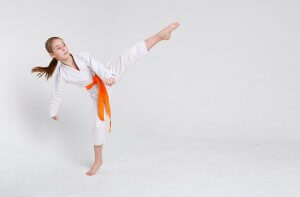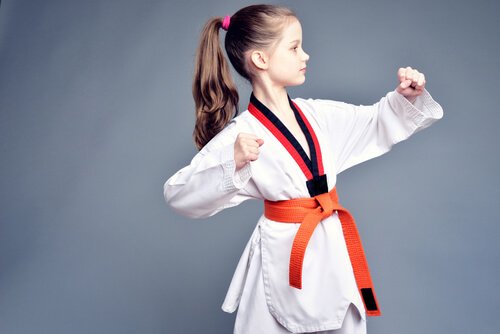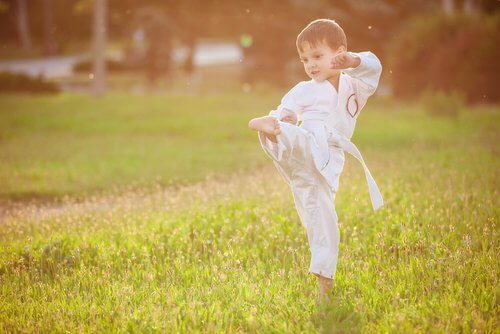The Benefits of Martial Arts for Children

When the time comes to sign your children up for a sport or physical activity, the first options to come to mind are probably soccer, basketball, swimming, etc. However, martial arts for children are also a very popular and beneficial alternative.
Certainly, when many think about these disciplines, they associate them with violence, hitting, falling, etc. However, they are integral sports that improve concentration and values, and aim for spiritual harmony.
It’s worth pointing out that martial arts for children don’t teach them to be aggressive or violent, as some may think. During combat, instructors teach participants that it doesn’t matter who wins or loses. Rather, what matters is enjoying the practice itself.
In this setting, professors don’t just teach sports. Martial arts serve as a guide to shape the mind and character. And they provide children with tools and values like respect, self-confidence and self-control.
This makes martial arts the perfect sport for children who are very impulsive or have a hard time concentrating. It’s also ideal for those with low self-esteem or problems socializing.
The benefits of martial arts for children
By practicing these disciplines, children don’t just carry out physical exercise that improve their flexibility and resistance. While doing so, they also learn a mechanism of self-defense.
Among the many benefits of martial arts for children are the following:
The physical benefits
- Martial arts help improve motor skills and increase resistance, agility, strength and flexibility, thanks to the movements involved.
- They correct posture and strengthen muscles.
- Given that children must concentrate on their bodies more often, they respond better to demands and increase their coordination and discipline.

Psychological benefits
- Increased self-esteem.
- Children learn sport values in an environment of positive competition.
- Kids who practice martial arts learn about important values and discipline. These include respect, hard work and humility, among others.
- Increased ability to concentrate.
- These disciplines instill respect for rules and for authority figures.
- Reduced behavioral problems.
Martial arts for children also offer many benefits that, unlike other sports, even help children who have attention or learning difficulties. This is thanks to the following factors:
- Martial arts allow children to obtain short-term goals and on an individual basis. With each level surpassed, children receive different colored ribbons, which help them gain self-confidence and security.
- They also improve memory through the repetition of routines. These routines allow children to advance through levels and add more movements.
- Levels out stress and promotes calm, respect, good behavior, both in class and out of class. .
“Martial arts for children don’t teach them to be aggressive or violent, as some may think.”
These sports may appear very attractive to our children, but several questions arise when it comes to their parents.
For example, what elements are necessary to practice these sports? At what age can kids get involved in martial arts? Which martial arts are the most appropriate?
To practice any martial art, children will need a uniform, which is usually white. These consist of a jacket, pants, and a belt. The color of the belt will change as children advance to new levels.
From the time children are three years old, there are many types of martial arts that they can practice. Those that require a greater amount of coordination are better for children over the age of 5.
The most common martial arts for children
- Taekowndo: This is a combat sport that employs the feet, hands and other parts of the body. While it’s recommended for children ages 4 and up, it can be adapted to any age.
- Judo: The aim of this discipline is to immobilize an opponent before hitting. The mission is to defeat adversaries using one’s own strength, coordination, balance and skill. Children can practice judo from the time they’re 3 years old.
- Karate: This martial art uses the hands and legs almost exclusively. The keys are dominating one’s own body posture, and the observation and analysis of the adversary’s movements. The main goal is to block and dodge hits and wait for the opportunity to reach the opponent’s weak spots.

Practicing sports from a young age isn’t only a source of fun and entertainment, it’s also a way for children to maintain a healthy body. Through sports, children strengthen their physical abilities and become less susceptible to illness.
Just like with any other sport, persistence and parental support play a vital role when it comes to martial arts. This applies both to daily practices as well as presentations and competitions.
As you can see, participating in martial arts carries a number of benefits for children’s mental, physical and emotional health. And what’s more, it strengthens the bonds between entire families and friendships.
When the time comes to sign your children up for a sport or physical activity, the first options to come to mind are probably soccer, basketball, swimming, etc. However, martial arts for children are also a very popular and beneficial alternative.
Certainly, when many think about these disciplines, they associate them with violence, hitting, falling, etc. However, they are integral sports that improve concentration and values, and aim for spiritual harmony.
It’s worth pointing out that martial arts for children don’t teach them to be aggressive or violent, as some may think. During combat, instructors teach participants that it doesn’t matter who wins or loses. Rather, what matters is enjoying the practice itself.
In this setting, professors don’t just teach sports. Martial arts serve as a guide to shape the mind and character. And they provide children with tools and values like respect, self-confidence and self-control.
This makes martial arts the perfect sport for children who are very impulsive or have a hard time concentrating. It’s also ideal for those with low self-esteem or problems socializing.
The benefits of martial arts for children
By practicing these disciplines, children don’t just carry out physical exercise that improve their flexibility and resistance. While doing so, they also learn a mechanism of self-defense.
Among the many benefits of martial arts for children are the following:
The physical benefits
- Martial arts help improve motor skills and increase resistance, agility, strength and flexibility, thanks to the movements involved.
- They correct posture and strengthen muscles.
- Given that children must concentrate on their bodies more often, they respond better to demands and increase their coordination and discipline.

Psychological benefits
- Increased self-esteem.
- Children learn sport values in an environment of positive competition.
- Kids who practice martial arts learn about important values and discipline. These include respect, hard work and humility, among others.
- Increased ability to concentrate.
- These disciplines instill respect for rules and for authority figures.
- Reduced behavioral problems.
Martial arts for children also offer many benefits that, unlike other sports, even help children who have attention or learning difficulties. This is thanks to the following factors:
- Martial arts allow children to obtain short-term goals and on an individual basis. With each level surpassed, children receive different colored ribbons, which help them gain self-confidence and security.
- They also improve memory through the repetition of routines. These routines allow children to advance through levels and add more movements.
- Levels out stress and promotes calm, respect, good behavior, both in class and out of class. .
“Martial arts for children don’t teach them to be aggressive or violent, as some may think.”
These sports may appear very attractive to our children, but several questions arise when it comes to their parents.
For example, what elements are necessary to practice these sports? At what age can kids get involved in martial arts? Which martial arts are the most appropriate?
To practice any martial art, children will need a uniform, which is usually white. These consist of a jacket, pants, and a belt. The color of the belt will change as children advance to new levels.
From the time children are three years old, there are many types of martial arts that they can practice. Those that require a greater amount of coordination are better for children over the age of 5.
The most common martial arts for children
- Taekowndo: This is a combat sport that employs the feet, hands and other parts of the body. While it’s recommended for children ages 4 and up, it can be adapted to any age.
- Judo: The aim of this discipline is to immobilize an opponent before hitting. The mission is to defeat adversaries using one’s own strength, coordination, balance and skill. Children can practice judo from the time they’re 3 years old.
- Karate: This martial art uses the hands and legs almost exclusively. The keys are dominating one’s own body posture, and the observation and analysis of the adversary’s movements. The main goal is to block and dodge hits and wait for the opportunity to reach the opponent’s weak spots.

Practicing sports from a young age isn’t only a source of fun and entertainment, it’s also a way for children to maintain a healthy body. Through sports, children strengthen their physical abilities and become less susceptible to illness.
Just like with any other sport, persistence and parental support play a vital role when it comes to martial arts. This applies both to daily practices as well as presentations and competitions.
As you can see, participating in martial arts carries a number of benefits for children’s mental, physical and emotional health. And what’s more, it strengthens the bonds between entire families and friendships.
All cited sources were thoroughly reviewed by our team to ensure their quality, reliability, currency, and validity. The bibliography of this article was considered reliable and of academic or scientific accuracy.
- Moody, G. H. (1999). Martial arts benefits for children (Doctoral dissertation, Arizona State University). http://academy.karatebuilt.com/Student_Site/About_Sr_Master_Moody_files/99Thesis.pdf
- Seabrook, J. A. (2003). Martial Arts Revealed: Benefits, Problems, and Solutions. iUniverse.
- Binder, B. (2007). Psychosocial benefits of the martial arts: Myth or reality. Int Ryuku Karate Res Soc J. https://www.researchgate.net/profile/Brad_Binder/publication/265567929_Psychosocial_Benefits_of_the_Martial_Arts_Myth_or_Reality_A_Literature_Review/links/54de00da0cf22a26721db438/Psychosocial-Benefits-of-the-Martial-Arts-Myth-or-Reality-A-Literature-Review.pdf
- Woodward, T. W. (2009). A review of the effects of martial arts practice on health. Wisconsin Medical Journal (WMJ), 108(1), 40. http://wismed.org/wisconsin
- McKeehan, J. (2012). The art of martial behavior: Using martial arts as a behavioral intervention for children with autistic spectrum disorders (Doctoral dissertation, Kaplan University). https://search.proquest.com/openview/24f9b7a28cef81adc54f7853c0801db3/1?pq-origsite=gscholar&cbl=18750&diss=y
This text is provided for informational purposes only and does not replace consultation with a professional. If in doubt, consult your specialist.








